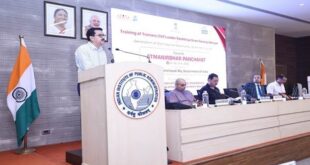- The Union Ministry of Health has issued a communique to States to resume genome sequencing of new cases of COVID-19, in view of the sudden spurt of cases in some parts of the world.
- In a letter, Union Health Secretary Rajesh Bhushan said sequencing of positive case samples will allow the Indian SARS-CoV-2 Genomics Consortium network to track the variants, enabling timely detection of newer variants, in order to undertake requisite public health measures in time.
- The Health Ministry has also advised people to mask up, though it is not yet mandatory. Health Minister Mansukh Mandaviya said: “COVID is not over yet… We are prepared to handle any situation.”
What was the situation in India in 2022?
- After ravaging the world for nearly two years, COVID-19 gave India a respite from the mid first quarter of 2022.
- While a total of 4.47 crore cases of COVID-19 were detected cumulatively in India, and the number of deaths stood at 5.31 lakh, the number of cases began going down from March 2022, with only 201 new cases reported on December 23.
- Consequently, restrictions that were imposed on public movement in the country were eased out. With the Indian government removing the Air Suvidha notification for international travel, end November, the last vestige of the pandemic protocol, was shed.
What is the global situation?
- In the U.S., a trifecta of viruses — Respiratory Syncytial Virus, Influenza and COVID-19 — led to a rising number of respiratory infection cases since September, accelerating post November.
- In China, the number of cases began to soar as it dropped its zero-COVID policy and lifted all restrictions, in response to unprecedented protests.
- Because of the sheer size of the population and the fact that the nation had not been exposed properly to the natural march of the virus, there has been a massive surge end of the year.
- It has reached a stage where the doubling time was just a few hours, according to some reports. This has apparently rendered it impossible to calculate the R Number (an indication of how fast the infection is spreading) anymore.
- Simultaneously in Brazil, Korea and Japan, rising numbers have been a source of concern.
What happened in China?
- Chennai-based infectious diseases specialist Subramanian Swaminathan says with its polar approaches, China made mistakes in handling the epidemic.
- “From stringent restrictions that were imposed thanks to a zero-COVID policy, they opened up, (because the public was getting restive), without any step down or gradual easing of restrictions. This can be very dangerous in health care.”
- It is also impossible to suppress an epidemic, he explains. Every pandemic will ‘equilibrate’, and over a period of time, level out infection levels across the world. It is not possible for some areas in the world to have a large number of cases, and others stop with low numbers.
- He concurs with epidemiologists who say “China’s vaccine is probably not great in neutralising the current variant, and vaccination coverage in the 60-plus group is poor.” China also has low hybrid immunity, which is immunity granted by the twin factors of natural infection and vaccination, since it artificially suppressed the waves of COVID-19 with harsh restrictions, he says.
- Eric Feigl-Ding is an epidemiologist and health economist whose health forecasts since early 2020 have been unfathomably close to reality, though they were initially termed alarmist. He has predicted a rising tsunami of cases.
- He believes that China will have about 80 crore infections in a matter of three months, i.e. 60% of its population will be impacted. He goes on to quote emerging reports from China of hospitalisations soaring, and long queues outside crematoria.
What are the future implications for India?
N.K. Arora, chief, National Immunisation Technical Advisory Group, said that the situation in India is under control, but vigil is necessary. The bulk of the adult population has been vaccinated, he said. About 70% of the country has been fully vaccinated, though booster vaccination is flagging.
He added that almost all the sub-variants of Omicron found across the world were circulating in India as well, and no alarming situation has emerged so far.
- Subramanian says the BF.7 variant, the latest one, was said to have an R Number of 10, which is pretty high.
- “However, this has not led to a high number of cases as evidenced by very little or no hospitalisations for COVID-19 over the past months.
- Nevertheless, the way ahead for India is to take up aggressive booster vaccination, and also look at rolling out the nasal vaccine that curbs transmission.”
- The government has just sanctioned the use of nasal vaccine for the 18-plus group as a booster.
- In a scenario where the number of tests has dropped (the total number of daily tests in India is at 1,15,734, against high prevalence States conducting a lakh or more tests daily during the peaks), he recommends conducting waste water surveillance for monitoring community infections.
- Chandrakant Lahariya, vaccines and public health expert, says there is no reason to panic, but points out that initiating genomic surveillance is a good idea.
- “In the current situation no two countries are comparable, particularly in terms of natural infection load and vaccination coverage.
- India has good hybrid immunity.” He, however, cautions that one needs to remain alert, particularly in terms of surveillance, considering that the true position hardly emerges from China.
SOURCE: THE HINDU, THE ECONOMIC TIMES, PIB
 Chinmaya IAS Academy – Current Affairs Chinmaya IAS Academy – Current Affairs
Chinmaya IAS Academy – Current Affairs Chinmaya IAS Academy – Current Affairs



